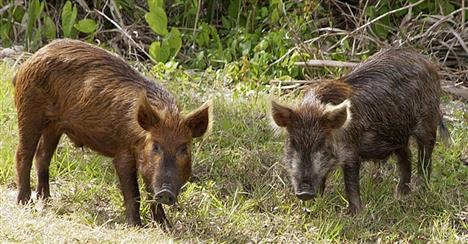Feral swine to be a problem in state for the ‘foreseeable future’
by May 21, 2023 9:05 pm 1,536 views

Through the years, these feral swine have moved into at least 35 states, including Arkansas. In the late 1990s, wild pigs were a minor problem in southern Arkansas, but ag scientist Dr. Greg Mathis began to warn colleagues that feral swine could become a serious problem in the decades to come.
He was right.
There are now at least 200,000 feral swine roaming the Natural State, Dr. Becky McPeake told Talk Business & Politics. A professor and wildlife specialist for the University of Arkansas Agriculture Extension, McPeake said feral swine cause more than $41 million in damages in Arkansas annually, according to recent U.S. Department of Agriculture (USDA) estimates. The hogs cause more than $2 billion damage a year nationwide.
“Feral hogs are everywhere … they reproduce very rapidly,” she said. “They’ve been here quite a long time.”
Feral swine are not native to the Americas, according to the USDA. Free-range livestock management practices and escapes from enclosures led to the first establishment of feral swine populations within the United States. In the 1900s, the Eurasian, or Russian wild boar, was introduced into parts of the United States for the purpose of sport hunting. Feral swine are a combination of escaped domestic pigs, Eurasian wild boars, and hybrids of the two, the USDA reported.
The feral swine population is estimated at more than 6 million and is rapidly expanding. Range expansion over the last few decades is due to several factors including their adaptability to a variety of climates and conditions, translocation by humans, and a lack of natural predators, according to the USDA.
Feral hogs are found in nearly all of Arkansas’ 75 counties. They are known to damage timber and croplands. In Arkansas, they are considered a nuisance animal and not indigenous wildlife.
Common swine damage to forest landowners includes girdling trees through rubbing and damaging roots by rooting and chewing. In the southern U.S., feral swine are also known to root up newly planted tree seedlings in plantations of pines and hardwood species. Nana Tian, a forest economics researcher for the Arkansas Forest Resources Center, said they can severely damage trees and timber resources.
Soybean, corn, and rice fields are a buffet table for a sounder of swine — the social unit of feral hogs. One sounder can root up a pasture overnight. Larger swine can kill and eat newborn calves and vulnerable cows. Feral swine teach their young how to evade traps and can trick even the most seasoned hunters and trappers. They are a problem for ranchers, farmers, and even golf course and cemetery managers, McPeake said.
One boar can typically cause as much damage to a pasture as a sounder, so it’s not just the number of pigs but ones that can cause more damage that are a problem, she added.
“There’s a lot of head scratching when examining how and why hogs do what they do,” she said.
In addition to property damage, feral swine carry diseases that can be transmitted to domestic pigs. According to the Arkansas Department of Agriculture’s Feral Hog Task Force, diseases of highest concern with feral swine include pseudorabies virus, swine brucellosis, swine influenza, African swine fever, classic swine fever, and foot and mouth disease.
Last year, the task force hired trappers through the USDA Natural Resources Conservation Service’s Feral Swine Eradication and Control Pilot Program. The trappers work in a 12-county area, and they have been successful in culling the number of sounders in those counties, McPeake said. From 2020-2022 more than 30,000 hogs were eradicated statewide.
Traps have been used for years to capture wild pigs, but it doesn’t take long for them to figure out ways to evade being trapped, she said. Electric fencing, poisonous baits and other methods have been tried, but each has its own problems. For example, poisons work on hogs but they can also be consumed by other wildlife.
Aerial shooting can be done through a permit, but McPeake said it’s not done for sport. One reason scientists suspect the feral swine population has exploded in recent years is due to recreational hog hunting in states such as Texas.
Females can produce a litter every 6-8 months with up to six piglets. Finding ways to limit their reproductive capacity may be the key to solving this problem, McPeake said.
There is mounting evidence that feral swine are encroaching into urban areas around the state, McPeake said. They’ve received several reports of animal control officers in cities encountering feral swine and the problem appears to be growing, she added.
“This has been a growing problem for many years,” she said. “It’s going to be a problem for the foreseeable future.”
